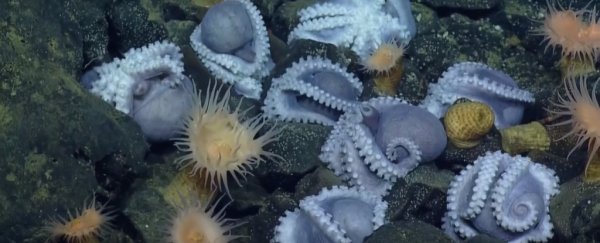In the waters off the coast of California, marine scientists are finding a whole world of cephalopod wonders: in the latest instalment, it's a vast number of octopuses huddling over their eggs in the crevices of an extinct underwater volcano.
With an estimated over 1,000 ockies spotted, the area at the Davidson Seamount has now been confirmed as the largest deep-sea octopus nursery ever discovered.
"This has never been discovered on the West Coast of the US, never in our sanctuary and never in the world with these numbers," Chad King, a lead scientist on the exploration vessel Nautilus, told KQED News.
As they moved their remotely operated underwater vehicle Hercules through the water at a depth of 3.2 kilometres (2 miles), the scientists spotted never-before-seen aggregations of Muusoctopus robustus octopuses.
An estimated 99 percent of them appeared to be brooding mothers, huddling upside down to protect the eggs they'd laid in crannies in the rock.
"We went down the eastern flank of this small hill, and that's when - boom - we just started seeing pockets of dozens here, dozens there, dozens everywhere," King told National Geographic.
The scale is unprecedented. Octopuses are largely known as solitary animals, and it's rare to spot a group of them in one place (although recent evidence suggests they might not be as solitary as we thought).
Earlier this year, the discovery of a deep Pacific Ocean octopus nursery of 100 or so animals on the Dorado Outcrop off the coast of Costa Rica was huge news - not least because it provided marine scientists with a fascinating glimpse into deep-sea octopus brooding behaviours.
At the Davidson Seamount, the researchers noticed that the water seemed to 'shimmer' around the octopuses; it could be an indication that warmer water is seeping out from inside the volcano, although we'll need temperature measurements to make sure that's the case.
If the water temperatures are verified, it might mean the octopuses are deliberately seeking out warmer water to incubate their eggs. Certainly the eggs in the E/V Nautilus video - what could be seen of them - seemed to be healthy and developing well.
But that contradicts the Dorado Outcrop discovery, where the octopuses (also of the Muusoctopus genus) were congregating around warmer volcanic fluid seeps as well.
Except the eggs in that octopus garden were faring poorly, which led the researchers to hypothesise that the mothers they saw had been too late to secure a good location.
The Davidson nursery, however, suggests that the warmer waters are the preferred location; so it's possible something else could have been harming the Dorado eggs.
The mystery could be cleared up once researchers confirm whether the shimmering of the water really indicates warmth - since the Davidson Seamount is an extinct volcano, it may not be emitting heat.
To find out for sure, the team will have to send the ROV back down to check it out. We can expect those results from a future trip, although unfortunately it might be a little while - there's a technical problem that's currently preventing a return trip. Fingers crossed!
